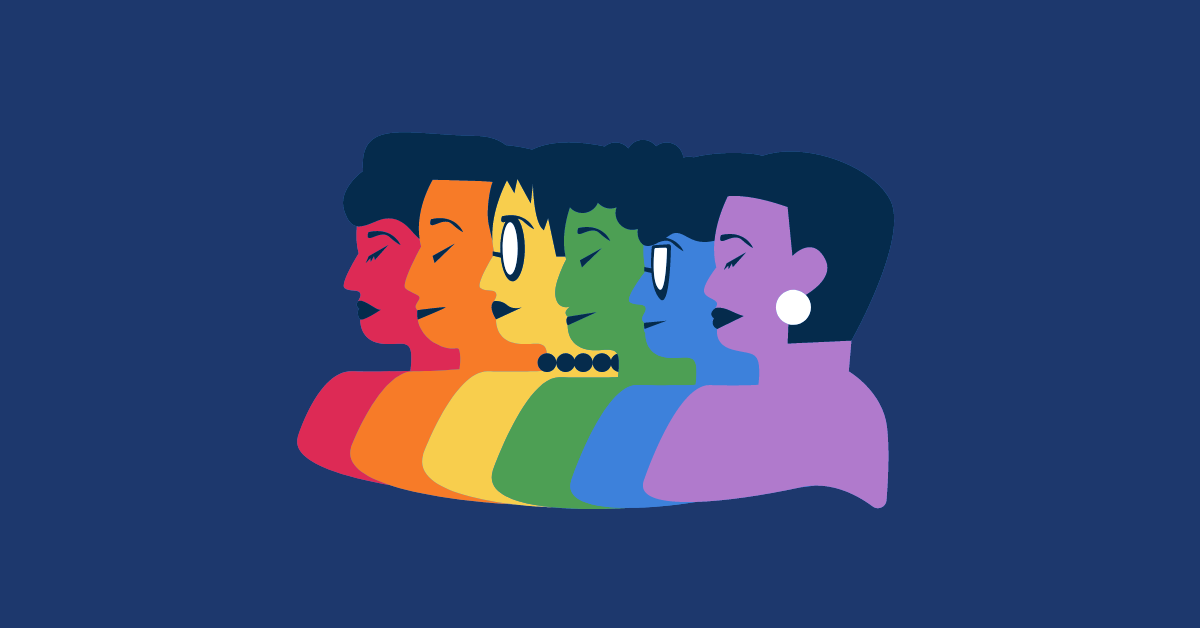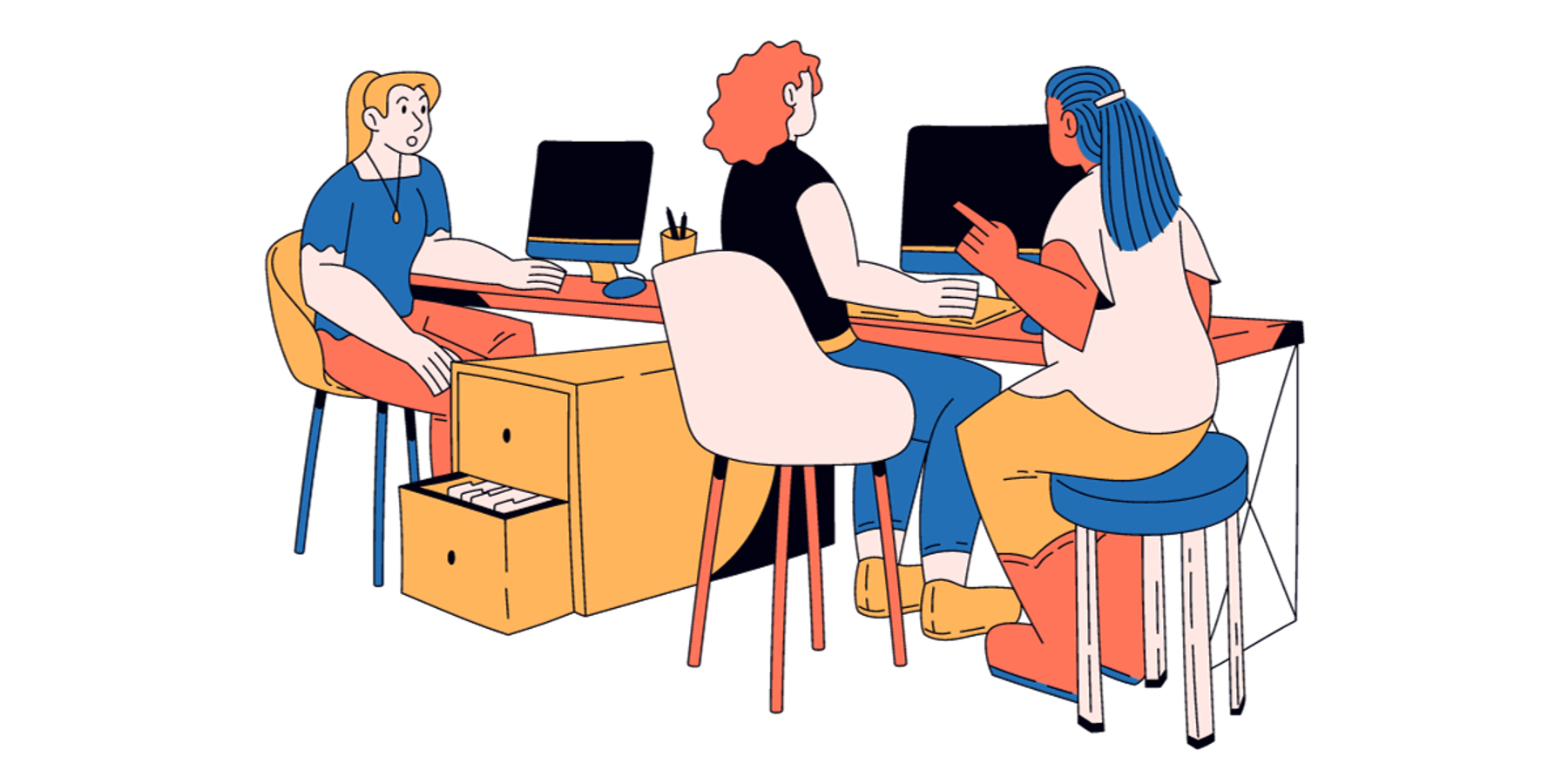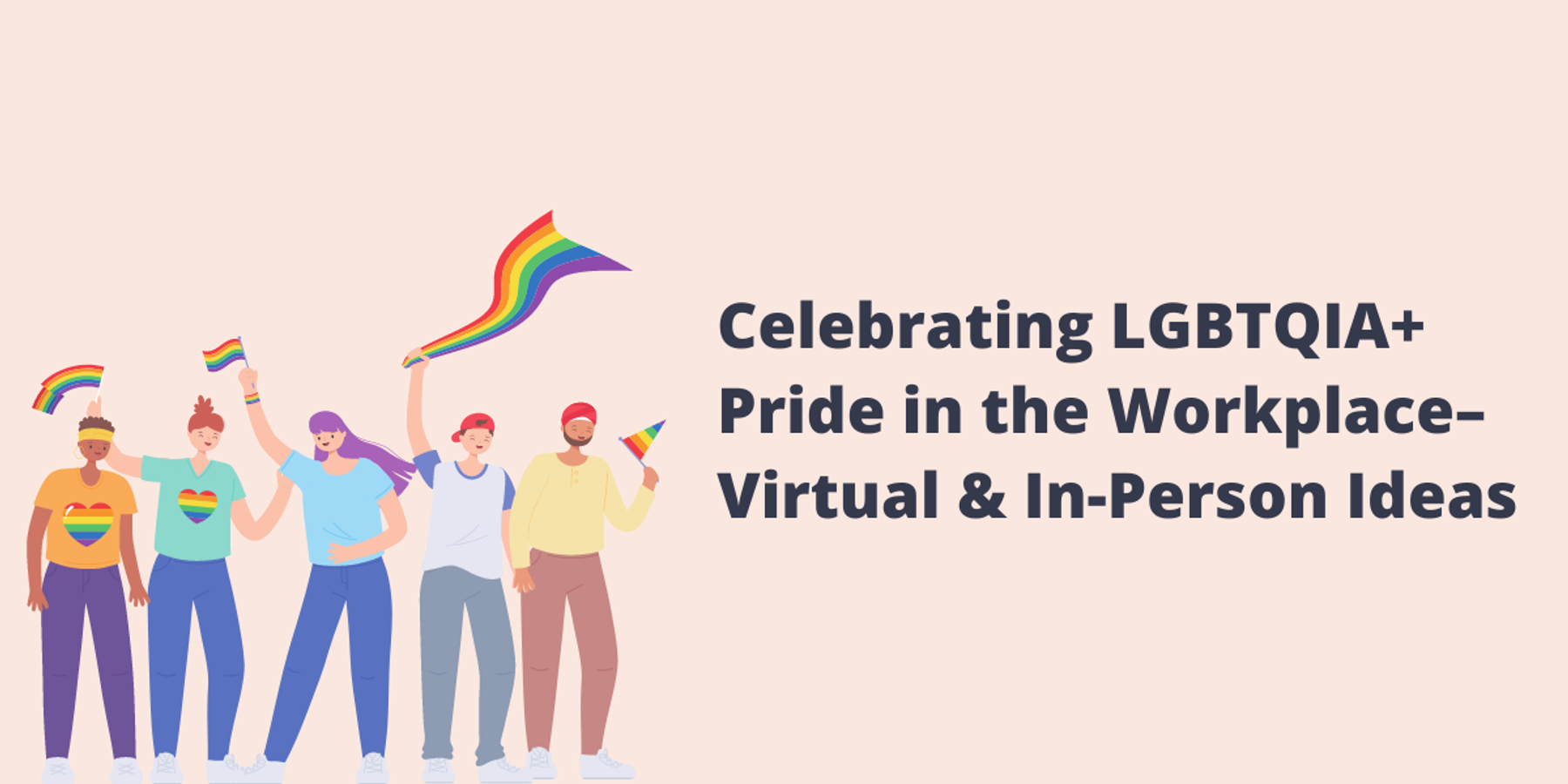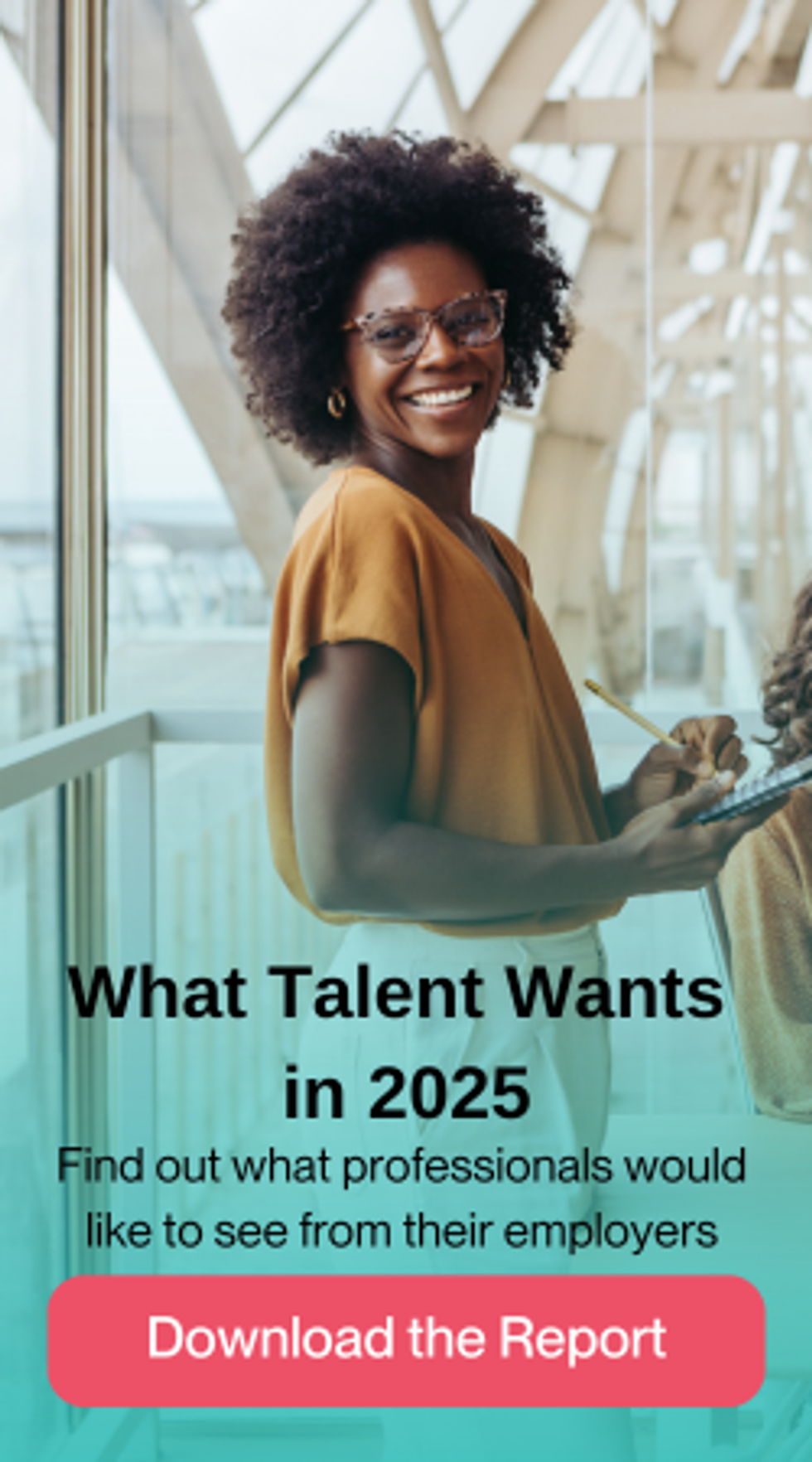Language — like people themselves — is constantly evolving. That’s true of the LGBTQIA+ acronym, too.
These letters represent a multi-faceted community, with LGBTQIA+ terminology often carrying specific nuance from one person to the next. The language about and for LGBTQIA+ people has been continually expanding since the earliest gay rights movements of the 1950s, and across the queer spectrum, people are continuing to find the terms and labels that best befit them. That's why it’s important to always ask versus assume you know how someone identifies.
For those outside the LGBTQIA+ community, the size of the acronym, as well as its plus sign at the end, might seem intimidating. You know you don’t want to unintentionally make a mistake and offend someone. So, what does LGBTQIA+ stand for exactly? This living, growing glossary will break down the different LGBTQIA+ definitions and help you understand what inclusion and belonging for each of these groups looks like in the workplace. After reading, you’ll hopefully feel a bit more prepared to foster open, affirming conversations with your LGBTQIA+ talent and colleagues.
What does LGBTQIA+ stand for?
Ready to explore the full LGBTQIA+ definition? Here we go, letter by letter.
L is for Lesbian
A lesbian is a woman who is primarily attracted to other women. This attraction could be emotional, romantic, sexual, or a combination of these. Cis women, trans women, and nonbinary individuals may all identify with this term.
G is for Gay
Gay describes a person who is attracted to people of their same gender. Men, women, and nonbinary individuals identify with this term. In the past, “gay” was used to specifically describe men who were attracted to men. It’s still used by that community, but it’s also been adopted as a broader umbrella term.
B is for Bisexual
A bisexual person is attracted to more than one gender or gender identity. This doesn’t mean that bisexual folks are engaged in multiple relationships at once (i.e. polyamory); it simply refers to who you can be romantically, emotionally, and/or sexually attracted to. The “bi” in bisexual, importantly, also doesn’t mean that bisexual people experience attraction only within a gender binary — or, are attracted to those who identify as men and women only — as critics of this label sometimes suggest. Ultimately, bisexual people experience attraction toward multiple genders. Simple.
T is for Trans
A trans or transgender person is someone whose gender identity or gender expression is not the same as the sex they were assigned at birth. Trans is a gender identity and not a sexual orientation like lesbian, gay, or bisexual. Trans people may identify as any sexual orientation. Trans is an umbrella term that encompasses a number of other gender identities such as: nonbinary, genderqueer, genderfluid, and more. A trans person does not necessarily want or experience a “transition” in physicality or dress in order to carry this term.
Q is for Queer or Questioning
Once a homophobic slur, the term queer was reclaimed by the LGBTQIA+ community. Now, it’s a broadly used term to express and encompass a variety of gender identities and sexual orientations that are outside of cishet (cisgender and heterosexual) molds. Q can also stand for questioning, which means people who are exploring their orientation or gender identity. There’s room for plenty of gray in the LGBTQIA+ rainbow, and many people’s understanding of their identity will evolve or change over time. That doesn’t mean that queerness is a “phase;” it means there’s often fluidity to both sexuality and gender.
I is for Intersex
Intersex people are born with sex traits, reproductive anatomy, and/or chromosomal patterns that live outside of binary definitions of male and female bodies. There is ample range in intersex variations, including in chromosomes, genitalia, internal sex organs, and hormone production. It is estimated that about 1 in 1,500 children are born intersex in the United States. Historically, intersex babies were assigned a gender at birth by their doctor, a practice that is now going out of favor.
A is for Asexual
Asexual or “ace” people experience a partial or total lack of sexual attraction or disinterest in sexual activity. Asexual people may still have emotional relationships and experience romantic attraction. For those who do, many in this community will use the modifiers /hetero, /homo, /bi, or /pan; for example, “ace/homo” refers to people who are romantically and/or emotionally attracted to their same gender, but not sexually attracted to that gender (or any gender).
+ is for limitless possibility
The “+” sign signifies the multitude of other terms that folks within the broader LGBTQIA+ community have developed to describe their orientations and gender identities. The plus is important as a marker of inclusion, expansiveness, and openness to the community. Just a few of the LGBTQIA+ identities that are represented in the acronym by the plus sign include: Agender (those who have no gender identity or are gender neutral); pansexual (those who can be attracted to anyone, regardless of gender identity, gender presentation, or sexual orientation); nonbinary (an umbrella term used to describe those who identify as not having a gender, not having a fixed gender, or as being between genders – many nonbinary people are not agender in the sense that they do have a relationship to gender and/or gender expression); and Two-Spirit (or 2S, an identity reserved for those who are Indigenous North American and occupy an alternative third or fourth gender, depending on the tribe, status that’s often associated with leadership and healing roles).
Alternatives like LGBT, LGBTQ, LGBTQIA2S+ and more
There are many variations of the LGBTQIA+ acronym. In the past, a shorter LGBT version of the acronym was most common, followed by LGBTQ. A more recent version used today, LGBTQQIP2SAA, stands for Lesbian, Gay, Bisexual, Queer, Questioning, Intersex, Pansexual, Two Spirit, Asexual, and ally.
Ultimately, the acronym exists to represent a wide community, foster conversations, name injustice, and generally engage with issues of sexuality and gender identity. Longer acronyms can help emphasize that everyone is welcome and included within the queer umbrella, and we encourage the companies we partner with to survey their queer workforce around the acronym and other related terms they feel most connected to and represented by.
At PowerToFly, in recognition of the fact that queerness represents infinite multitudes and is a living, evolving thing, we use LGBTQIA+, always with the plus sign, ourselves. And when referring to a specific community within this acronym, we also follow the DEIB principle of saying who we mean. (Example: If you’re talking about an issue that impacts trans people specifically, say trans and not LGBTQIA+.)
Download our free guide, Inclusive Language At Work, to discover broad inclusive language best practices, as well as some specific examples of words to use and to avoid.
What is LGBTQIA+ diversity?
LGBTQIA+ diversity means the representation and recognition of all the gender identities and sexual orientations that exist.
Tokenism is hiring one gay, White, cis man and saying “job done.” An authentic DEIB mission starts with a diverse workforce, but it doesn’t end there. Together with inclusion and belonging, the workplace is a space where LGBTQIA+ people can be themselves, feel safe, and feel valued.
The LGBTQIA+ experience in the workplace
According to the Human Rights Campaign, 46% of LGBTQIA+ workers are closeted at work.
A double standard
Eighty percent of non-LGBTQIA+ people agree that people should not have to hide who they are at work. Yet, 59% of non-LGBTQIA+ people think it’s inappropriate to talk about sexual orientation and gender identity in the workplace.
Microaggressions and inaction
Fifty-three percent of LGBTQIA+ folks report hearing jokes about lesbian, gay, or trans people. Only 37% of non-LGBTQIA+ people report hearing them. Still 35% of non-LGBTQIA+ workers report being willing to let negative comments go unaddressed.
Consequences
- 1 in 4 LGBTQIA+ workers has avoided certain people at work for fear of facing homophobia
- 1 in 5 LGBTQIA+ workers has stayed home because their workplace wasn’t accepting
- 1 in 10 LGBTQIA+ workers has left a job because the environment wasn’t accepting
How can we build inclusive workplaces for LGBTQIA+ people?
Workplace inclusion for LGBTQIA+ people is critical, particularly now when so many LGBTQIA+ rights are under attack in the United States. Below, here are some LGBTQIA+-friendly policies for you to start implementing as you look to improve intentional inclusion and belonging for queer folks in your workplace.
- Start an LGBTQIA+ Employee Resource Group (ERG). If it doesn’t exist already, start one. HR needs to create opportunities for the LGBTQIA+ people in your company to network and experience community. This can help offer peer support, and the ERG can also provide some much-needed feedback to leadership about queer experiences at the organization.
- Be proactive about pronouns. Non-LGBTQIA+ people need to take the lead when it comes to pronouns. Put them on your email signature, LinkedIn profiles, and name badges, lead with your pronouns in meetings. When pronouns are just for trans people, it can single them out and invite bias and discrimination.
- Gender-neutral bathrooms. This is a clear and concrete way to support a gender-neutral environment. And it’s easy to start: for all individual bathrooms and those with privacy doors on stalls, remove the female/male emoji off the wall.
- Reconsider family benefits. For companies with offices in states where there’s a lack or limit to marriage and family equality, reconsider how you compensate workers with family benefits. If your insurance policies do not allow unmarried people to receive certain health or tax benefits, consider salary increases, incentives, or other ways to compensate.
- Training. Company-wide DEIB training equips workers with the right tools to recognize unconscious bias and microaggressions. Next, help employees to have difficult conversations about queer issues, identities, and experiences. It is critical that both senior and middle management participate.
What does LGBTQIA+ stand for? A true example of inclusion.
Hiding who you are is exhausting. When LGBTQIA+ people talk about their personal lives in the same way that non-LGBTQIA+ people always have at work, it’s not “sexualizing the workplace.” It’s removing bias and reinforcing inclusion as the norm. There are some simple steps HR can take to start tackling the discrimination that LGBTQIA+ people face. Learning what LGBTQIA+ stands for is an important first step. If you’re ready to step further into allyship, check out our free guide to inclusive LGBTQIA+ employee benefits and policies for the workplace, and consider scheduling a consultation with our team of expert DEIB strategists and trainers on deepening LGBTQIA+ inclusion at your organization.




